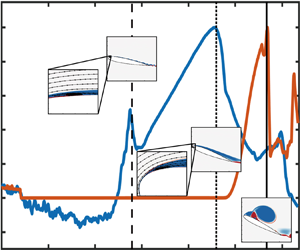Published online by Cambridge University Press: 28 February 2022

During a dynamic stall process, various flow structures leave their pressure footprints on a wing surface, through which it is possible to understand the development of different flow stages and predict the critical flow events. Based on a classical airfoil ramp-up pitching motion, proper orthogonal decomposition analysis of pressure on the suction surface is carried out in this study. Accordingly, the surface pressure evolution during dynamic stall is summarized into three basic physical schemas, based on which several real-time critical indicators for predicting the flow events related to the dynamic stall vortex (DSV) are constructed. These critical indicators include the spatial distribution coefficient of pressure (SDCP), the high-order central moment of pressure (HCMP), the location of peak pressure (LPP) and the modulated location of peak pressure (MLPP). These indicators can predict the formation of laminar separation bubbles, DSV initiation, DSV centre position and the detachment of DSV. Therefore, the real-time whole-life monitoring of DSV has been realized. Moreover, the effectiveness of these indicators has also been confirmed under different parameters, and testing using wind tunnel experimental data proves their noise robustness. Studies show that the SDCP and HCMP may also be effective even if only two transducers are used. Finally, a modification method of SDCP based on Z-score standardized pressure is proposed. It is found that the modified SDCP can effectively reduce sensitivity to kinematic parameters and the Reynolds number. The critical indicators in this study can be used as a reference for the standardized mathematical and physical description of DSV evolution, thus laying a foundation for constructing a universal theoretical framework of dynamic stall.